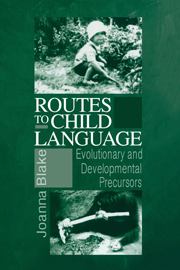Book contents
- Frontmatter
- Contents
- Preface
- 1 Prelinguistic Vocalizations
- 2 Sound–Meaning Correspondences
- 3 Communicative Gestures
- 4 Symbolic Gestures and Symbolic Play
- 5 Tool Use and Object Concept
- 6 Representation in Human Infants
- 7 Memory in Nonhuman Primates and Young Children
- 8 Origins of Language
- 9 Recapitulation
- References
- Index
Preface
Published online by Cambridge University Press: 12 January 2010
- Frontmatter
- Contents
- Preface
- 1 Prelinguistic Vocalizations
- 2 Sound–Meaning Correspondences
- 3 Communicative Gestures
- 4 Symbolic Gestures and Symbolic Play
- 5 Tool Use and Object Concept
- 6 Representation in Human Infants
- 7 Memory in Nonhuman Primates and Young Children
- 8 Origins of Language
- 9 Recapitulation
- References
- Index
Summary
The purpose of this book is to address the issue of continuity, both phylogenetic continuity across species and ontogenetic continuity across infancy to childhood. The focus is on behaviors that have been proposed as essential precursors of language: nonmeaningful sound production; early mapping of meaning onto sound; communicative hand and body movements (communicative gestures); movements that represent actions and objects (symbolic gestures); pretend play involving toy animation and imaginary use of objects; use of an object to achieve a goal (tool use); understanding of how objects behave in space, whether visible or not (object permanence); and memory for spatial layouts, objects in arrays, actions and events (delayed imitation), and lists of items (auditory memory). All of these precursors have been investigated in human infants with regard to their impact on early language, as well as others that will not be treated. Emotional factors that may be crucial for language, namely early processing of facial expressions and attachment, will not be included. These precursors have been addressed in recent books by Bloom (1993) and Locke (1993). I will also focus on language production with less emphasis on language comprehension, except for standardized tests of receptive language. This is because the vast majority of research on the precursors that I have selected is focused on their relation to language production. Speech perception will also not be covered; it has been reviewed recently by Jusczyk (1997).
- Type
- Chapter
- Information
- Routes to Child LanguageEvolutionary and Developmental Precursors, pp. xi - xivPublisher: Cambridge University PressPrint publication year: 2000



